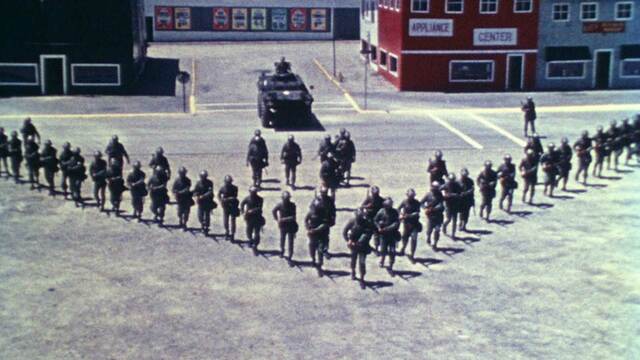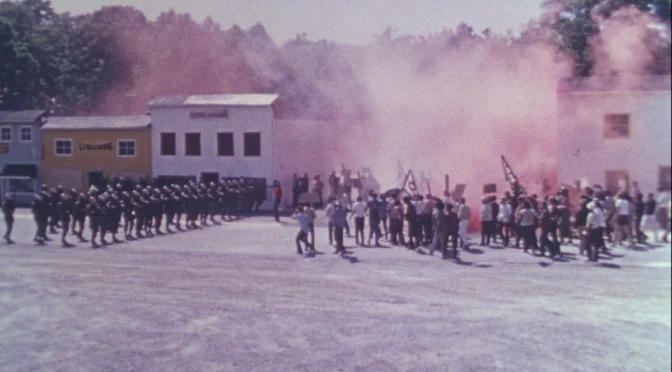Article by: Alice Ferro
Translated by: Arianna Deiro
A neat line of shops appears on screen, billboards sparkle on the walls and the vibrant technicolour of the Sixties almost gives us a sense of peace. It looks like a typical post-war American city, quiet and geometric, maybe too much. The narrating voice asks, “What are we looking at?” and a doubt awakens in us: the buildings are as fake as panels of a set design, the roads look as if they’ve never been walked on, the paint on the signs is new and shiny. This is Riotsville, one of the fake cities built by the American government in the Sixties as military training bases. In these cities, crowds of plain-clothes soldiers staged riots, complete with an audience and cheers, so that their colleagues could learn how to contain them, all in preparation for the civil rights protests that would unleash in the Summer.
While our collective imagery associates the year 1968 with striking, revolutionary scenes, Riotsville, USA takes a completely different path. The movie combines archive footage of training sessions with footage of newscast of that time. The goal of the director, Sierra Pettingel, an archive researcher, is to explore the way in which US national consciousness takes shape, the tools used by the institutions to influence media narrative and, therefore, public opinion. The repercussions of this narrative, evident to this day, could already be found in the footage of the time. The “white and respectable” ladies learn how to hold a gun and how to shoot, because television told them that black communities are rebellious and ready for anything.

This type of narrative has consequences on training from a practical standpoint, too. Soldiers are ordered to treat white protesters differently from “professional rioters”, which means black ones. We are thus witnesses to a process that is still happening: the gradual militarization of the police force that affects black communities and specific neighbourhoods, located in cities that even now appear to be virtually segregated. Photography has also contributed to this process: by capturing the instant, which is the outbreak of the crisis, it fails to show the causes in their full complexity. Images of the protests, which are taken out of context, have long justified the ways in which black communities have been repressed by the police. It’s not surprising that photography is absent in Riotsville, USA. This is a calculated absence.
It is frustrating to witness the “dress rehearsal” of a system of oppression but, from the director’s point of view, this can paradoxically give us hope, because it allows us to realize that this system has intentionally been manufactured and, therefore, it can be dismantled. .

